CHIROPRACTIC CARE
The purpose of chiropractic care is to correct fixation in spinal motion segments, which can be partially described as a loss of proper joint function or mechanical motion. These fixations may or may not also be compromising associated nerves. Fixations can be caused by physical trauma, environmental factors, poor posture, mental/emotional stress, and toxins. We combine various chiropractic adjustment techniques including upper cervical, activator, diversified, cox flexion distraction, thompson technique, and applied kinesiology, with adjunctive therapies, such as decompression therapy, therapeutic massage, electronic muscle stimulation, ultrasound, exercise rehabilitation, and nutritional counseling. Chiropractic care that provides chiropractic adjustment produces many benefits including decreased pain, increased range of motion, better posture and coordination, increased flexibility, increased energy and well-being.
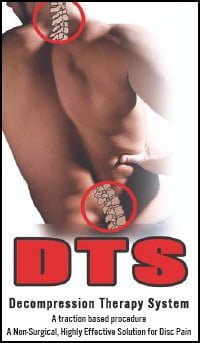
For more information see the FAQs.
PHYSICAL THERAPY, MASSAGE THERAPY, AND OTHER REHABILITATION SERVICES
Treatment programs in our office includes rehabilitative therapy. We want to not only resolve a person’s current symptoms, but also to strengthen his/her body and prevent against re-injury and joint degeneration. The different rehabilitation services we perform in our office include:
Disc Decompression Therapy
We offer non-surgical spinal disc decompression treatments through use of the FDA-approved decompression therapy system. This non-surgical treatment option is effective for patients with back pain due to lumbar disc herniation, degenerative disc disease, sciatica, facet syndrome and spinal stenosis. Clinical studies have shown that DTS treatments are more than 86% effective in relieving lower back pain and sciatica.
This treatment is designed to correct the underlying problem, not just relieve the symptoms of low back pain. DTS therapy reduces the pressure inside the discs, thereby shrinking disc herniations and drawing in necessary fluids and nutrients. Reduction of the disc pressure also promotes healing of annular tears. Restoring the disc nucleus restores disc height, thereby relieving pressure from inflamed nerve roots and facet joints. DTS therapy is so comfortable it is not uncommon for patients to fall asleep during treatments. A regimen of treatments over the course of twenty sessions is usually indicated for most patients.
Exercise Therapy
These therapies include: aerobics, stretching, stabilization and weight resistance. Depending on the injury, the symptoms and the patient’s needs, the doctor can tailor the exercises accordingly. Exercise therapy is used to:Relax tight muscles
-Increase joint mobility and stability
-Increase bone mass and muscular strength
-Improve posture, coordination, and endurance
Four Tips for Stretching
| a. | The first thing to remember when starting a stretching program is that the goal is to increase flexibility and functioning of the muscle. We are not trying to inflict pain. If you are feeling pain during a stretch there are a couple of things you can do. First try decreasing the intensity of the stretch by not going into the stretch as far. If there is still pain, then stop doing the stretch and ask your doctor what you should do. Stretches can be modified by your doctor so that they are not causing any pain. Note: While we don’t want to feel any pain, the stretch should be a little uncomfortable. If there is no feeling of tension or a slight ache (but not a painful ache), then the stretching is not being done effectively. |
| b. | Always follow the instructions given to you by your doctor. There are some general “rules” that you can follow, however, if you are stretching on your own. Hold the stretch for 20-30 seconds, without bouncing. If the stretch isn’t held long enough, it will not be effective. If the stretch is held to long, or done with bouncing, injury could occur. The more often you stretch the more effective stretching will be. You don’t, however, start out by stretching four times a day. Start by stretching once or twice a day and gradually increase the frequency as your body adjusts to the stretching program. |
| c. | It takes one to two weeks of stretching before you will note any changes in flexibility or function of the muscle. So don’t get discouraged if it seems that the stretches are not working. It is also important to be patient with yourself, don’t push too hard because the stretch is not working fast enough. |
| d. | Remember there is always another way to stretch the same muscle. So don’t let yourself get bored. Stretching can be fun, and having a wide variety of stretches will help you keep your interest and motivation to continue stretching. You can always ask your doctor for another stretch, a different variation of a stretch, or even for an opinion on a stretch you discovered yourself. |
Shoulder Stretch
This stretch will relax several muscles surrounding the shoulder. Here are two different ways to do this stretch. The stretch on the left is easier to do and is easier on your shoulder joint. If you have ever had shoulder problems I recommend doing the stretch as shown on the left. It is important to keep your head neutral and gaze straight ahead (done well in the picture to the left, but not in the picture on the right).
Note: In the left picture (desktop) or top picture (mobile), the shoulder being stretched is the right shoulder. In the right picture (desktop) or bottom picture (mobile), the shoulder being stretched is the left shoulder.
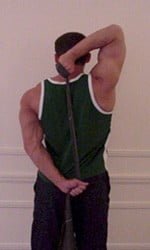
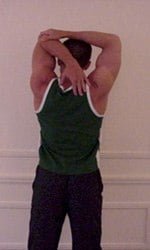
Wrist Flexors and Extensors Stretch
This stretch is good for anyone who uses their hands or arms a lot. Working with computers, working at a checkout counter, knitting, playing musical instruments, playing tennis, and many other activities, can cause your wrist flexors and extensors to become tight and problematic.
Note: The elbow is fully extended and arm is straight on the side that is being stretched. The flexor stretch is shown on the left (desktop) top (mobile) and the extensor stretch is shown on the right (desktop) bottom (mobile).
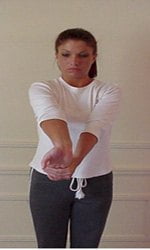
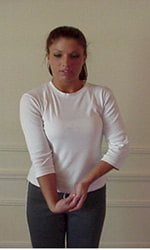
A Stretch for Computer Workers:
The diagram on the right
illustrates a six step series of
stretches that can be done by
anyone who works at a computer
work station. You should take a
stretch break after every hour
that you spend on the computer.
In case it’s not completely
self-explanatory, step C
involves clenching your fists as
tight as you can for a few
seconds, and step F is to relax
and let your hands and wrists go
limp for a few seconds.
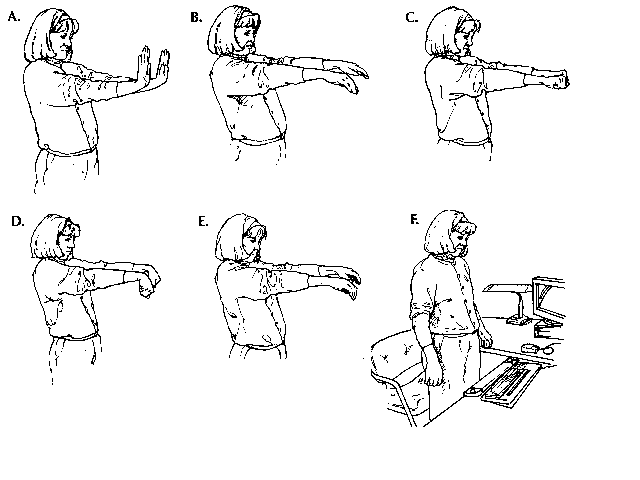
Gluteal Muscle Stretch
For this stretch it is important
to make sure that your back is
flat as you lean forward. Also,
hard to see in this picture, is
that there is no pressure put
directly on the knee joint.
Light pressure is put both above
and below the knee joint (the
knee of the foot that is not on
the floor) equally at the same
time. The leg on the floor: knee
should be at a 90 degree angle,
the knee should be directly over
the ankle, the toes should be
pointed straight ahead.
This is great to do at your
desk!
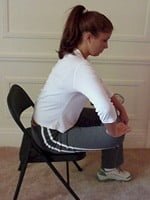
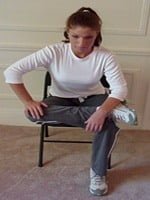
Quadriceps Stretch
It is important to note that in
this stretch the non-weight
bearing upper and lower leg are
lined up (front view). The foot
is touching (or almost touching)
the buttock and is not off to
either side. The bent knee is
aimed straight down. The foot
that is bearing weight, is
pointed straight ahead.
If you can not yet reach your
foot in the back, wrap a towel
(belts and ropes also work)
around your ankle and pull in
the same direction that you
would if you could grab your
foot.

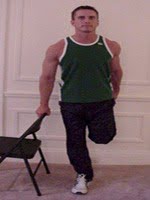
Massage And Pressure Point Therapy
These therapies can be used for the treatment of many different conditions because they:
-Relax tight muscles and remove toxins from tissues
-Reduce pain and improve posture
-Enhance circulation
-Facilitate muscular and joint healing
Microcurrent Therapy
This electrotherapy device sends out healing electronic impulses that produce no physical sensation. This therapy is used to:
-Reduce pain
-Decrease swelling and edema
-Speed the healing of injured tissues
Cervical And Lumbar Distraction
Using special tables, this therapeutic technique is used to gently manipulate subluxated joints. It is extremely effective for treating spinal disk herniations and bulges.
Interferential And Synaptic Therapy
These machines emit electrical impulses that produce a pleasant tingling sensation in the injured area. They are used to:
-Reduce pain and edema
-Relax tight muscles
Ultrasound
Ultrasound creates a feeling of warmth and tingling over the injured area. It is used to:
-Improve circulation
-Provide heat as a form of massage
-Reduce swelling
-Decrease pain
Infrared Light Therapy
The purpose of low level infrared light therapy is to direct a cool beam of light through the skin and into injured tissues. It speeds healing and relieves pain.
Heat And Ice
Combining these two therapies, or using them independently for specific injuries has many benefits.
Heat therapy can:
-Relax muscles
-Improve circulation
-Reduce chronic inflammation
Ice therapy can:
-Reduce acute inflammation
-Relieve pain
| Disclaimer: Thank you for visiting the scrantonchiro.com web page after trying to find a chiropractor near me. Please note that the information located on our site is not intended to provide specific chiropractic care or advice. You should consult with a chiropractic care doctor and not rely on any information contained herein regarding your specific condition. We welcome the receipt of electronic communication. Please be advised, however, that the act of sending electronic communication to this office or to Alfred Canal, D.C. does not alone create a physician-patient relationship. We will neither accept requests for chiropractic care advice or treatment nor offer specific chiropractic care advice over the internet. The information here is presented for general informational purposes only and is not intended to be used as a substitute for medical advice. |